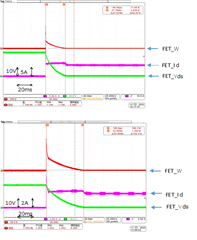Hello,
I would like to ask you about the SOA of CSD19536KTT.
The attached figure shows the waveform when the FET turns on.
Is the behavior shown in this waveform acceptable for SOA?
Also, please provide the temperature derating information for SOA as it will be used at TA=85°C. image as shown below.
Best regards,




